CHEVROLET KODIAK 2008 Owners Manual
Manufacturer: CHEVROLET, Model Year: 2008, Model line: KODIAK, Model: CHEVROLET KODIAK 2008Pages: 384, PDF Size: 5.4 MB
Page 111 of 384
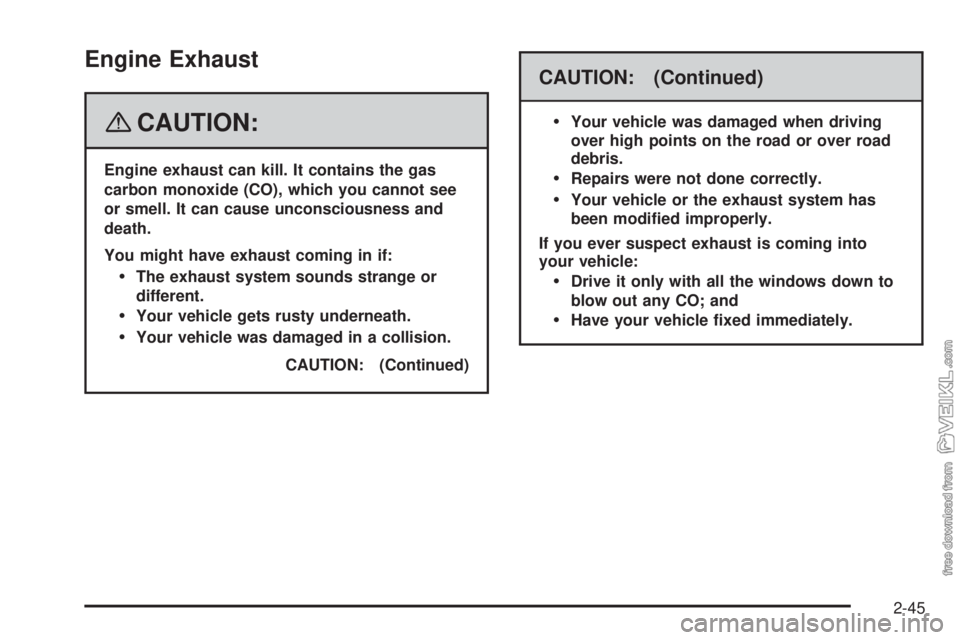
Engine Exhaust
{CAUTION:
Engine exhaust can kill. It contains the gas
carbon monoxide (CO), which you cannot see
or smell. It can cause unconsciousness and
death.
You might have exhaust coming in if:
The exhaust system sounds strange or
different.
Your vehicle gets rusty underneath.
Your vehicle was damaged in a collision.
CAUTION: (Continued)
CAUTION: (Continued)
Your vehicle was damaged when driving
over high points on the road or over road
debris.
Repairs were not done correctly.
Your vehicle or the exhaust system has
been modi�ed improperly.
If you ever suspect exhaust is coming into
your vehicle:
Drive it only with all the windows down to
blow out any CO; and
Have your vehicle �xed immediately.
2-45
Page 112 of 384
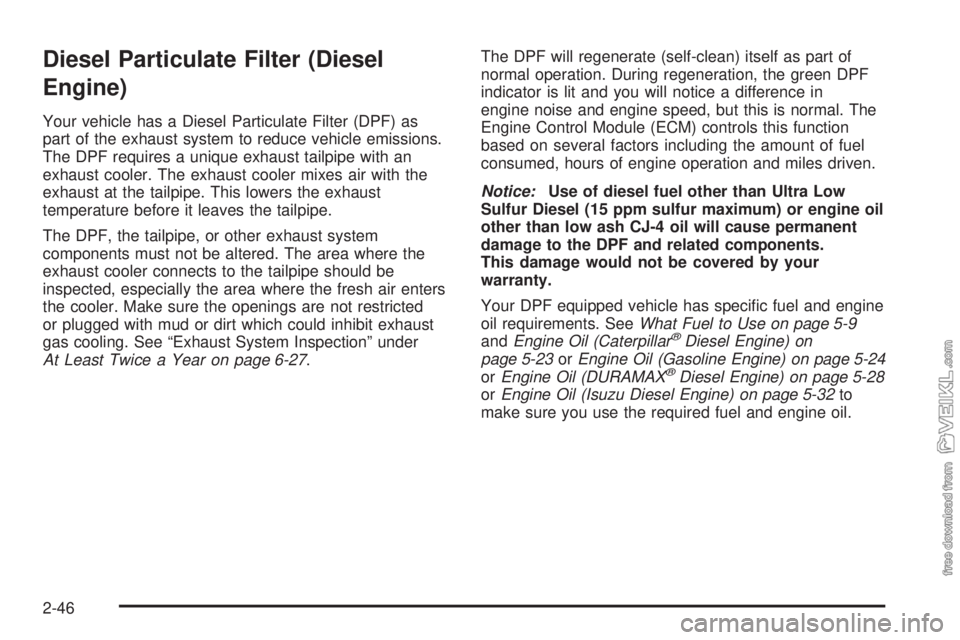
Diesel Particulate Filter (Diesel
Engine)
Your vehicle has a Diesel Particulate Filter (DPF) as
part of the exhaust system to reduce vehicle emissions.
The DPF requires a unique exhaust tailpipe with an
exhaust cooler. The exhaust cooler mixes air with the
exhaust at the tailpipe. This lowers the exhaust
temperature before it leaves the tailpipe.
The DPF, the tailpipe, or other exhaust system
components must not be altered. The area where the
exhaust cooler connects to the tailpipe should be
inspected, especially the area where the fresh air enters
the cooler. Make sure the openings are not restricted
or plugged with mud or dirt which could inhibit exhaust
gas cooling. See “Exhaust System Inspection” under
At Least Twice a Year on page 6-27.The DPF will regenerate (self-clean) itself as part of
normal operation. During regeneration, the green DPF
indicator is lit and you will notice a difference in
engine noise and engine speed, but this is normal. The
Engine Control Module (ECM) controls this function
based on several factors including the amount of fuel
consumed, hours of engine operation and miles driven.
Notice:Use of diesel fuel other than Ultra Low
Sulfur Diesel (15 ppm sulfur maximum) or engine oil
other than low ash CJ-4 oil will cause permanent
damage to the DPF and related components.
This damage would not be covered by your
warranty.
Your DPF equipped vehicle has specific fuel and engine
oil requirements. SeeWhat Fuel to Use on page 5-9
andEngine Oil (Caterpillar
®Diesel Engine) on
page 5-23orEngine Oil (Gasoline Engine) on page 5-24
orEngine Oil (DURAMAX
®Diesel Engine) on page 5-28
orEngine Oil (Isuzu Diesel Engine) on page 5-32to
make sure you use the required fuel and engine oil.
2-46
Page 113 of 384
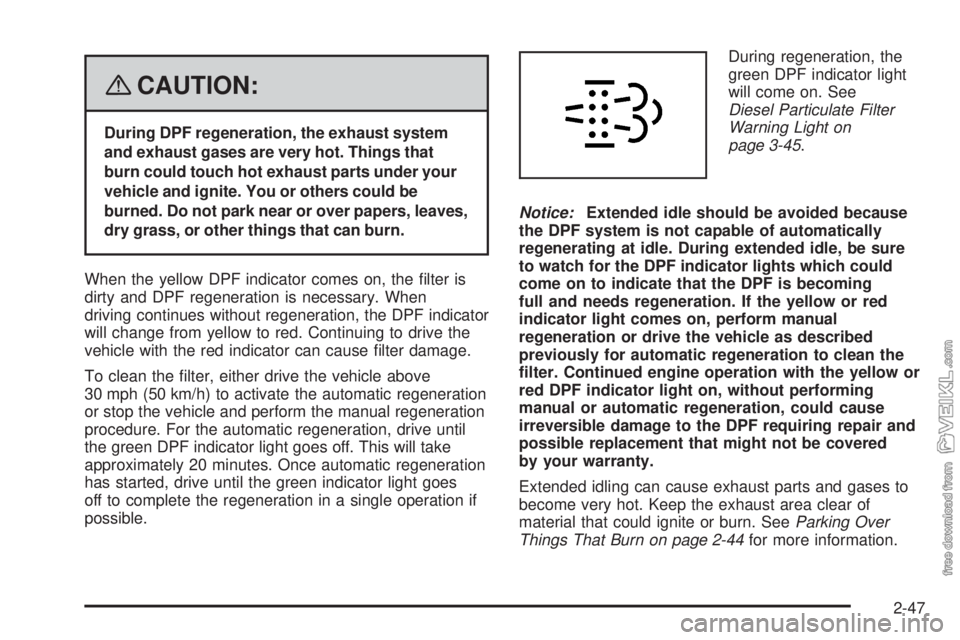
{CAUTION:
During DPF regeneration, the exhaust system
and exhaust gases are very hot. Things that
burn could touch hot exhaust parts under your
vehicle and ignite. You or others could be
burned. Do not park near or over papers, leaves,
dry grass, or other things that can burn.
When the yellow DPF indicator comes on, the filter is
dirty and DPF regeneration is necessary. When
driving continues without regeneration, the DPF indicator
will change from yellow to red. Continuing to drive the
vehicle with the red indicator can cause filter damage.
To clean the filter, either drive the vehicle above
30 mph (50 km/h) to activate the automatic regeneration
or stop the vehicle and perform the manual regeneration
procedure. For the automatic regeneration, drive until
the green DPF indicator light goes off. This will take
approximately 20 minutes. Once automatic regeneration
has started, drive until the green indicator light goes
off to complete the regeneration in a single operation if
possible.During regeneration, the
green DPF indicator light
will come on. See
Diesel Particulate Filter
Warning Light on
page 3-45.
Notice:Extended idle should be avoided because
the DPF system is not capable of automatically
regenerating at idle. During extended idle, be sure
to watch for the DPF indicator lights which could
come on to indicate that the DPF is becoming
full and needs regeneration. If the yellow or red
indicator light comes on, perform manual
regeneration or drive the vehicle as described
previously for automatic regeneration to clean the
�lter. Continued engine operation with the yellow or
red DPF indicator light on, without performing
manual or automatic regeneration, could cause
irreversible damage to the DPF requiring repair and
possible replacement that might not be covered
by your warranty.
Extended idling can cause exhaust parts and gases to
become very hot. Keep the exhaust area clear of
material that could ignite or burn. SeeParking Over
Things That Burn on page 2-44for more information.
2-47
Page 114 of 384
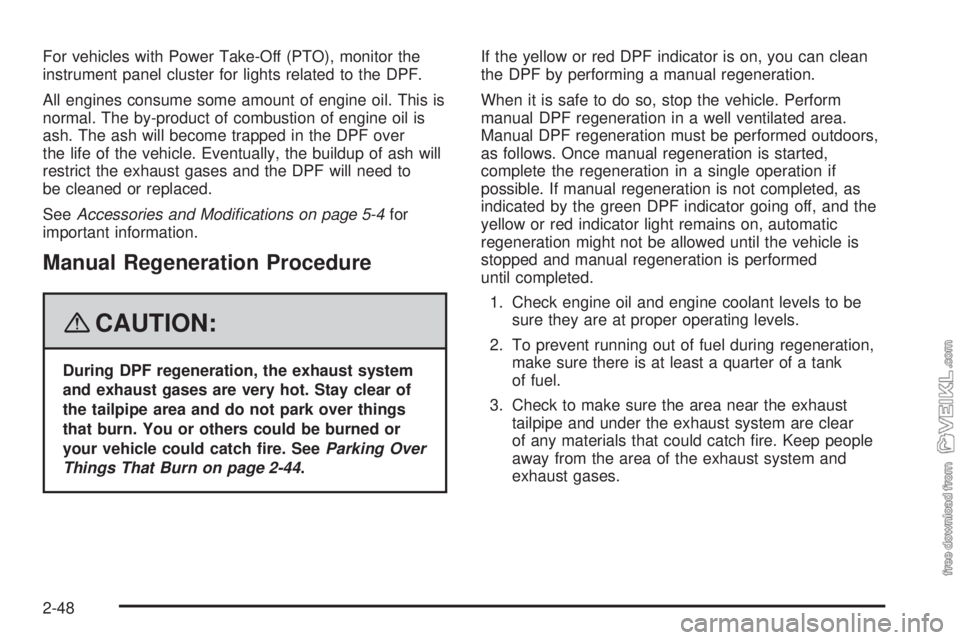
For vehicles with Power Take-Off (PTO), monitor the
instrument panel cluster for lights related to the DPF.
All engines consume some amount of engine oil. This is
normal. The by-product of combustion of engine oil is
ash. The ash will become trapped in the DPF over
the life of the vehicle. Eventually, the buildup of ash will
restrict the exhaust gases and the DPF will need to
be cleaned or replaced.
SeeAccessories and Modifications on page 5-4for
important information.
Manual Regeneration Procedure
{CAUTION:
During DPF regeneration, the exhaust system
and exhaust gases are very hot. Stay clear of
the tailpipe area and do not park over things
that burn. You or others could be burned or
your vehicle could catch �re. SeeParking Over
Things That Burn on page 2-44.If the yellow or red DPF indicator is on, you can clean
the DPF by performing a manual regeneration.
When it is safe to do so, stop the vehicle. Perform
manual DPF regeneration in a well ventilated area.
Manual DPF regeneration must be performed outdoors,
as follows. Once manual regeneration is started,
complete the regeneration in a single operation if
possible. If manual regeneration is not completed, as
indicated by the green DPF indicator going off, and the
yellow or red indicator light remains on, automatic
regeneration might not be allowed until the vehicle is
stopped and manual regeneration is performed
until completed.
1. Check engine oil and engine coolant levels to be
sure they are at proper operating levels.
2. To prevent running out of fuel during regeneration,
make sure there is at least a quarter of a tank
of fuel.
3. Check to make sure the area near the exhaust
tailpipe and under the exhaust system are clear
of any materials that could catch fire. Keep people
away from the area of the exhaust system and
exhaust gases.
2-48
Page 115 of 384
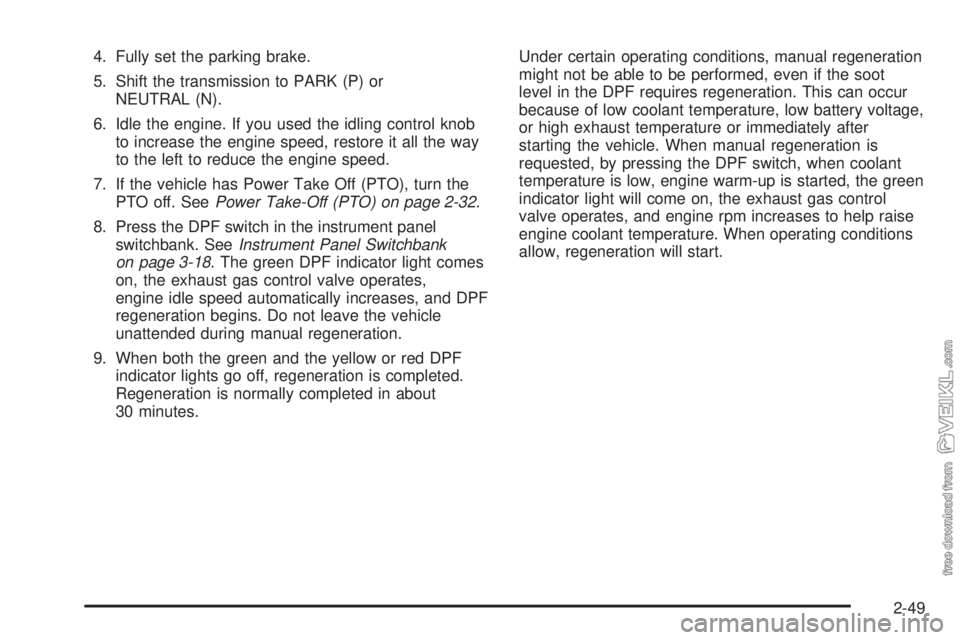
4. Fully set the parking brake.
5. Shift the transmission to PARK (P) or
NEUTRAL (N).
6. Idle the engine. If you used the idling control knob
to increase the engine speed, restore it all the way
to the left to reduce the engine speed.
7. If the vehicle has Power Take Off (PTO), turn the
PTO off. SeePower Take-Off (PTO) on page 2-32.
8. Press the DPF switch in the instrument panel
switchbank. SeeInstrument Panel Switchbank
on page 3-18. The green DPF indicator light comes
on, the exhaust gas control valve operates,
engine idle speed automatically increases, and DPF
regeneration begins. Do not leave the vehicle
unattended during manual regeneration.
9. When both the green and the yellow or red DPF
indicator lights go off, regeneration is completed.
Regeneration is normally completed in about
30 minutes.Under certain operating conditions, manual regeneration
might not be able to be performed, even if the soot
level in the DPF requires regeneration. This can occur
because of low coolant temperature, low battery voltage,
or high exhaust temperature or immediately after
starting the vehicle. When manual regeneration is
requested, by pressing the DPF switch, when coolant
temperature is low, engine warm-up is started, the green
indicator light will come on, the exhaust gas control
valve operates, and engine rpm increases to help raise
engine coolant temperature. When operating conditions
allow, regeneration will start.
2-49
Page 116 of 384
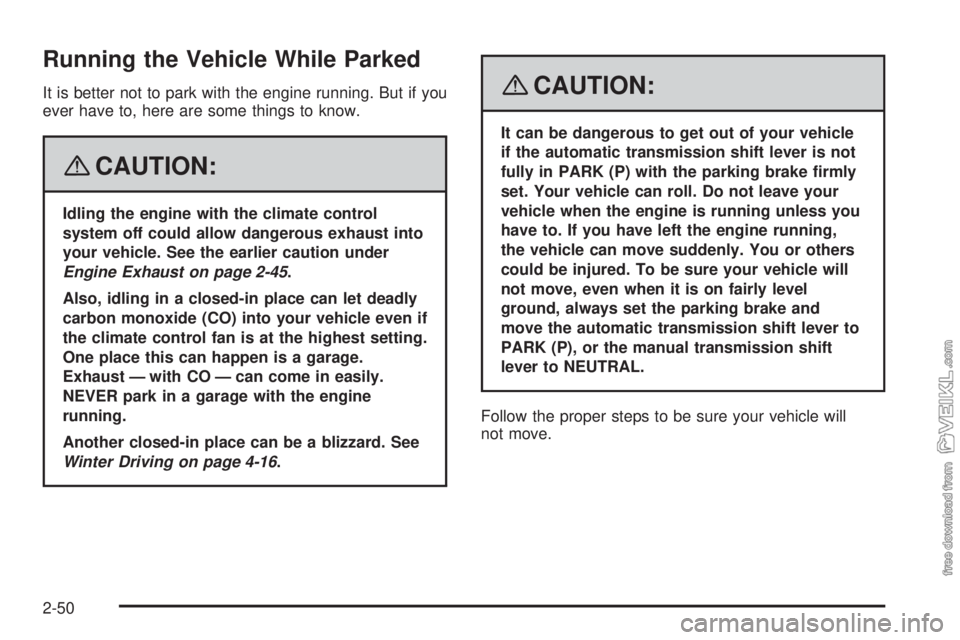
Running the Vehicle While Parked
It is better not to park with the engine running. But if you
ever have to, here are some things to know.
{CAUTION:
Idling the engine with the climate control
system off could allow dangerous exhaust into
your vehicle. See the earlier caution under
Engine Exhaust on page 2-45.
Also, idling in a closed-in place can let deadly
carbon monoxide (CO) into your vehicle even if
the climate control fan is at the highest setting.
One place this can happen is a garage.
Exhaust — with CO — can come in easily.
NEVER park in a garage with the engine
running.
Another closed-in place can be a blizzard. See
Winter Driving on page 4-16.
{CAUTION:
It can be dangerous to get out of your vehicle
if the automatic transmission shift lever is not
fully in PARK (P) with the parking brake �rmly
set. Your vehicle can roll. Do not leave your
vehicle when the engine is running unless you
have to. If you have left the engine running,
the vehicle can move suddenly. You or others
could be injured. To be sure your vehicle will
not move, even when it is on fairly level
ground, always set the parking brake and
move the automatic transmission shift lever to
PARK (P), or the manual transmission shift
lever to NEUTRAL.
Follow the proper steps to be sure your vehicle will
not move.
2-50
Page 117 of 384
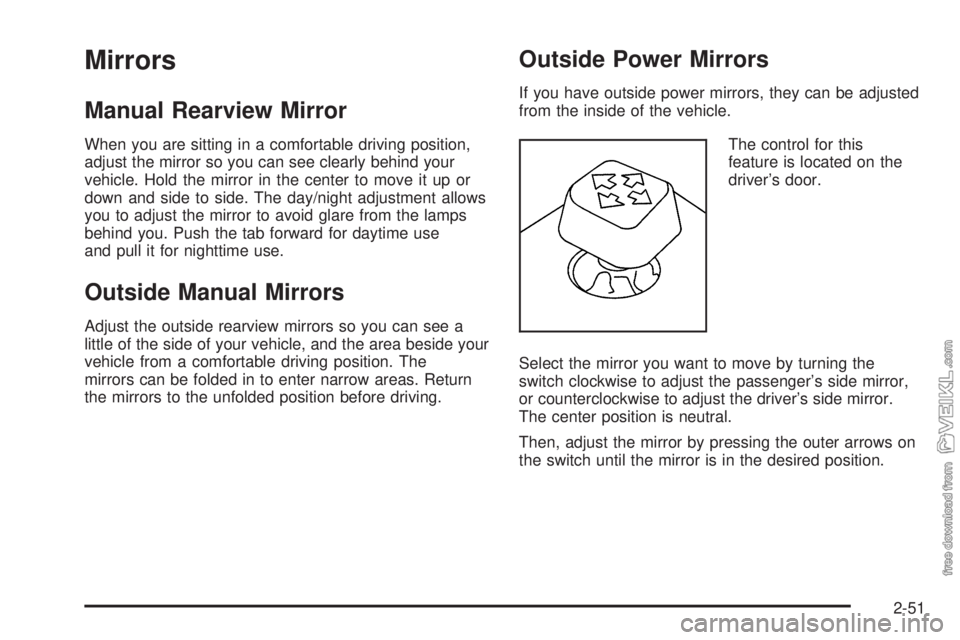
Mirrors
Manual Rearview Mirror
When you are sitting in a comfortable driving position,
adjust the mirror so you can see clearly behind your
vehicle. Hold the mirror in the center to move it up or
down and side to side. The day/night adjustment allows
you to adjust the mirror to avoid glare from the lamps
behind you. Push the tab forward for daytime use
and pull it for nighttime use.
Outside Manual Mirrors
Adjust the outside rearview mirrors so you can see a
little of the side of your vehicle, and the area beside your
vehicle from a comfortable driving position. The
mirrors can be folded in to enter narrow areas. Return
the mirrors to the unfolded position before driving.
Outside Power Mirrors
If you have outside power mirrors, they can be adjusted
from the inside of the vehicle.
The control for this
feature is located on the
driver’s door.
Select the mirror you want to move by turning the
switch clockwise to adjust the passenger’s side mirror,
or counterclockwise to adjust the driver’s side mirror.
The center position is neutral.
Then, adjust the mirror by pressing the outer arrows on
the switch until the mirror is in the desired position.
2-51
Page 118 of 384
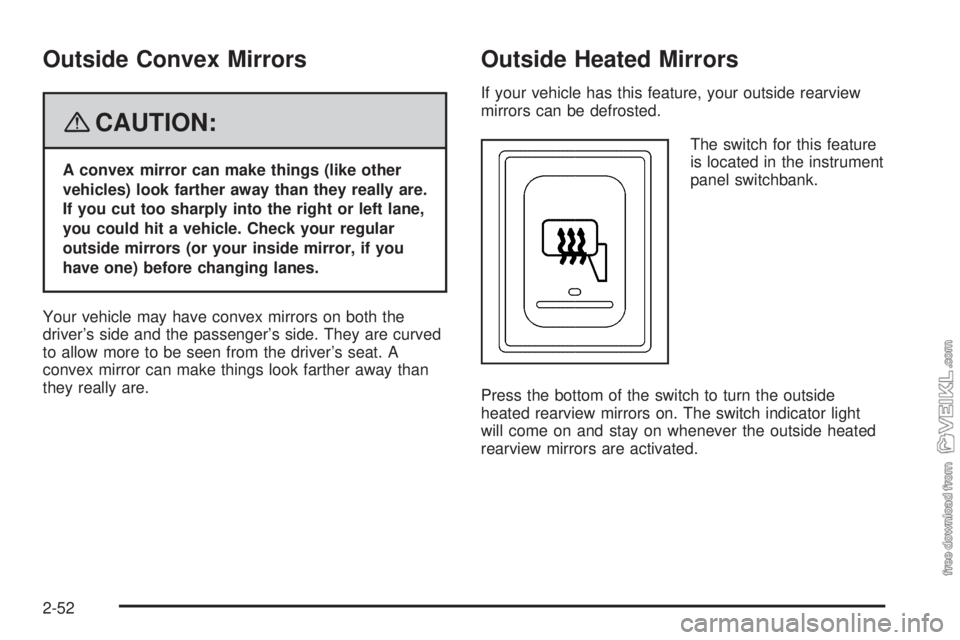
Outside Convex Mirrors
{CAUTION:
A convex mirror can make things (like other
vehicles) look farther away than they really are.
If you cut too sharply into the right or left lane,
you could hit a vehicle. Check your regular
outside mirrors (or your inside mirror, if you
have one) before changing lanes.
Your vehicle may have convex mirrors on both the
driver’s side and the passenger’s side. They are curved
to allow more to be seen from the driver’s seat. A
convex mirror can make things look farther away than
they really are.
Outside Heated Mirrors
If your vehicle has this feature, your outside rearview
mirrors can be defrosted.
The switch for this feature
is located in the instrument
panel switchbank.
Press the bottom of the switch to turn the outside
heated rearview mirrors on. The switch indicator light
will come on and stay on whenever the outside heated
rearview mirrors are activated.
2-52
Page 119 of 384
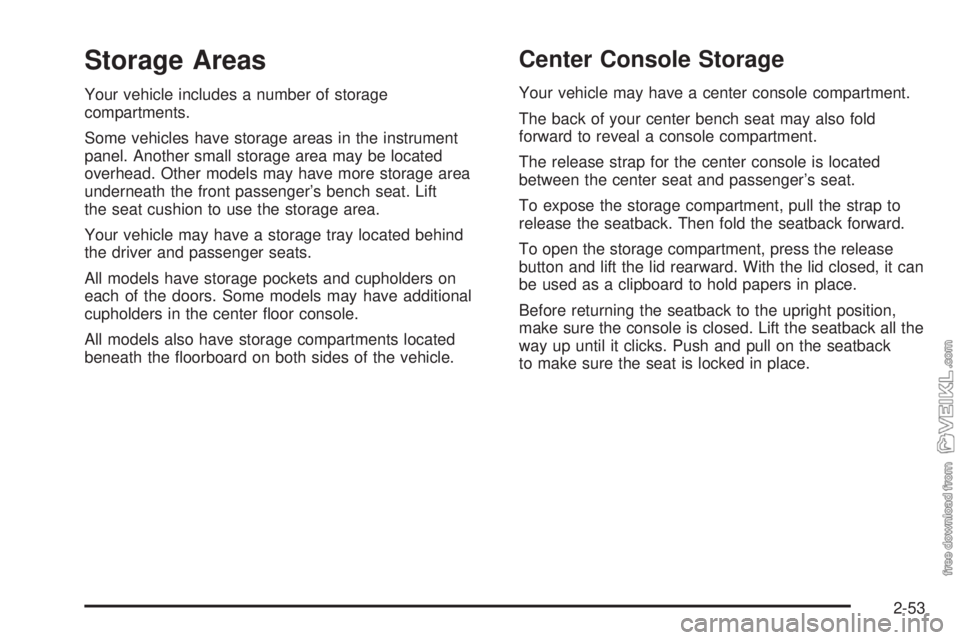
Storage Areas
Your vehicle includes a number of storage
compartments.
Some vehicles have storage areas in the instrument
panel. Another small storage area may be located
overhead. Other models may have more storage area
underneath the front passenger’s bench seat. Lift
the seat cushion to use the storage area.
Your vehicle may have a storage tray located behind
the driver and passenger seats.
All models have storage pockets and cupholders on
each of the doors. Some models may have additional
cupholders in the center floor console.
All models also have storage compartments located
beneath the floorboard on both sides of the vehicle.
Center Console Storage
Your vehicle may have a center console compartment.
The back of your center bench seat may also fold
forward to reveal a console compartment.
The release strap for the center console is located
between the center seat and passenger’s seat.
To expose the storage compartment, pull the strap to
release the seatback. Then fold the seatback forward.
To open the storage compartment, press the release
button and lift the lid rearward. With the lid closed, it can
be used as a clipboard to hold papers in place.
Before returning the seatback to the upright position,
make sure the console is closed. Lift the seatback all the
way up until it clicks. Push and pull on the seatback
to make sure the seat is locked in place.
2-53
Page 120 of 384
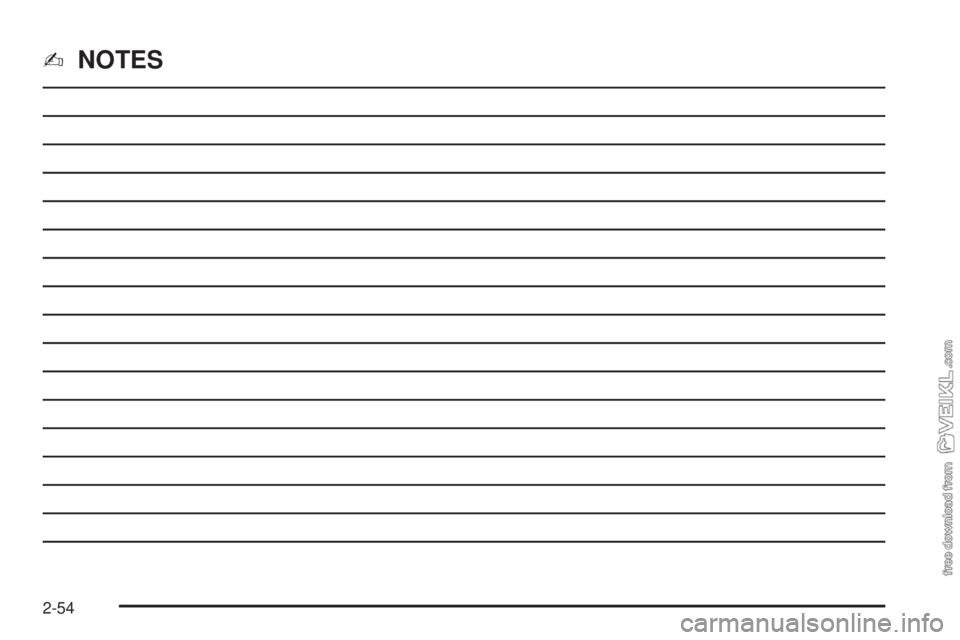
✍NOTES
2-54